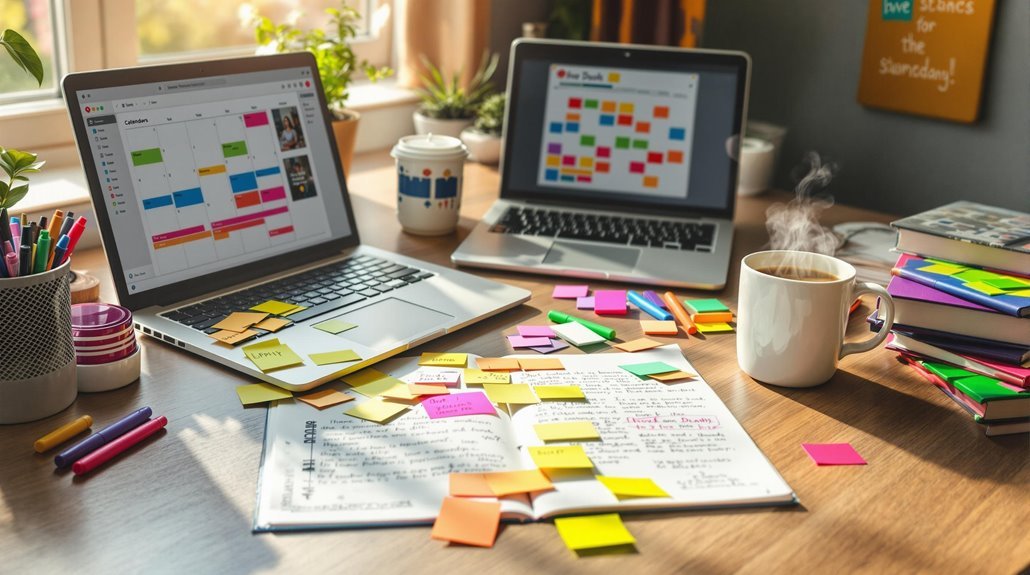To boost your grades, start by uncovering your learning style—whether visual, auditory, or kinesthetic—and tailor your study methods accordingly. Organize study materials using techniques like mind mapping and flashcards. Active engagement is key, so participate in discussions and form study groups for deeper understanding. Master time management with the Pomodoro Technique and create a study schedule to keep you on track. Prioritize self-care through balanced nutrition and regular exercise to maintain focus. By implementing these strategies, you'll gain crucial skills that make study sessions effective and enjoyable—keep exploring for even more useful tips!
Key Takeaways
- Utilize the Pomodoro Technique to enhance focus by working in focused intervals followed by short breaks, improving productivity and retention.
- Organize study materials using mind maps and flashcards for better engagement and memory retention through visual aids.
- Form study groups to leverage collaborative learning, gaining diverse perspectives that deepen understanding and improve critical thinking.
- Incorporate regular physical activity and a balanced diet to boost cognitive performance and maintain energy levels during study sessions.
- Employ spaced learning to review material at increasing intervals, reinforcing long-term memory retention and understanding of concepts.
Discover Your Learning Style

How do you learn best? Understanding your learning preferences is key to maximizing your study strategies. There are four main styles: visual, auditory, kinesthetic, and reading/writing. If you're a visual learner, you thrive on graphics, charts, and written notes. Transform your notes into diagrams to improve retention. Auditory learners, on the other hand, benefit from discussions and lectures. Try recording classes and summarizing key points aloud for effective memorization.
If you find yourself needing to move to learn, you might be a kinesthetic learner. Accept hands-on activities and engage in group work for better understanding. Break up study sessions with physical activity to keep your mind sharp. Understanding learning styles enhances success in learning transfer, allowing you to tailor your study habits to fit your unique preferences.
Lastly, reading/writing learners excel with written information. Annotate texts and create lists to condense and rephrase material.
Organize Study Materials Effectively
To truly organize your study materials effectively, think about using techniques like chunking, mind mapping, and creating flashcards. These strategies not only help you categorize information but likewise make studying more engaging and manageable. By applying them, you can improve your understanding and retention, setting yourself up for academic success. Additionally, consider designating a specific area for studying, as it can further enhance your focus and efficiency.
Chunking for Clarity
Chunking for clarity is an effective strategy that can transform the way you organize your study materials. By breaking down large bits of information into smaller, manageable pieces, you can improve your understanding and retention of complex topics. This approach aligns with fundamental memory strategies, making it easier for you to grasp the bigger picture.
Here are some chunking techniques you can implement:
- Note Organization: Utilize methods like the Cornell Method or Bullet Point Method to structure your notes.
- Summary Sections: Create concise summaries for quick reviews and self-testing.
- Visual Aids: Incorporate bullet points, headings, and color coding to visually differentiate information.
- Hierarchical Structure: Organize your materials with main topics and subtopics to create clear pathways through your content.
Mind Mapping Techniques
After mastering chunking techniques for clarity, exploring mind mapping can further boost your study efficiency. Mind mapping is a powerful tool that improves your creative brainstorming and visual thinking skills, making it easier to organize complex information. Start by placing your primary topic in the center of the page. This central theme acts as a springboard for your ideas.
Branch out by identifying key subtopics related to your main idea. Use concise keywords and phrases to label each branch clearly. This not only helps you remember important concepts but likewise aids in visual clarity. By employing vivid colors and illustrations, you can improve memory retention and make your mind maps more engaging.
Don't forget to add detailed information as smaller twigs on each branch, providing depth without overwhelming yourself. Consider using tools like MindMeister or Coggle for digital mind mapping, which allow for easy collaboration and multimedia integration.
Effective Flashcard Creation
How can you transform your study routine with effective flashcard creation? By utilizing the potential of flashcards, you can improve your learning experience and bolster retention through spaced repetition. Here are some key strategies to reflect upon:
- Focus on One Idea per Card: Keep each card simple, targeting a single concept to prevent confusion.
- Precision in Questions and Answers: Use clear, specific prompts that require distinct answers to reinforce understanding.
- Engage Higher-Order Thinking: Challenge yourself with active recall techniques, like cloze deletions, which force your brain to work harder.
- Organizational Strategies: Categorize your flashcards by subjects, employ color-coding, and utilize search options for quick access.
Engage With Active Learning

When you actively engage with your course material, you greatly improve your understanding and retention of information. Active participation transforms your learning experience by allowing you to connect new knowledge with what you already know, making it easier to remember. Instead of passively listening or reading, immerse yourself in hands-on activities and collaborative learning experiences that enrich your critical thinking skills.
Participating in group discussions or team projects not only boosts your interest but also nurtures a community of learners. When you work together, you tackle challenges, share diverse perspectives, and strengthen your communication abilities. This collaborative approach helps you analyze, evaluate, and synthesize information, sharpening your problem-solving skills in real-life situations.
Furthermore, active learning provides immediate feedback, correcting misconceptions and deepening your understanding of complex concepts. By participating in role-playing or case studies, you practice applying theories in various contexts, making the material more relevant and memorable. Remember, the more you engage, the more motivated you'll be to learn, leading to higher levels of achievement and success. So, welcome active learning and watch your grades soar!
Master Time Management
To master time management, you need to prioritize tasks effectively and use timers strategically. Start by identifying which assignments will have the biggest impact on your grades and tackle those first. Then, set timers to keep yourself focused during study sessions, ensuring you make the most of your productive time.
Prioritize Tasks Effectively
Effective task prioritization is essential for mastering time management and achieving better grades. By honing your prioritization strategies, you can tackle your assignments with greater efficiency and less stress. Start by categorizing tasks based on their urgency and importance. Consider using tools like the Eisenhower Matrix or the Ivy Lee Prioritization Template to establish a clear focus.
Here are some effective strategies to prioritize your tasks:
- Write down all tasks to avoid mental overload and break them into manageable parts.
- Utilize the 1-3-9 technique, focusing on one vital task, three important tasks, and nine nice-to-do tasks.
- Apply the Pareto Principle, concentrating on the 20% of tasks that will yield 80% of your results.
- Label tasks by urgency, subject, or type using a color-coding system for visual clarity.
Use Timers Strategically
Mastering time management doesn't just stop with prioritizing tasks; using timers strategically can take your productivity to the next level. Timers serve as powerful visual aids, offering clear representations of passing time. This is especially beneficial if you struggle with ADHD or executive functioning challenges, as it helps you visualize time limits and structure your tasks effectively.
One popular method is the Pomodoro Technique, where you work in focused 25-minute intervals followed by a 5-minute break. This approach reduces procrastination and distractions while enhancing concentration and preventing burnout. You'll find that breaking tasks into smaller chunks makes them more manageable.
Time blocking and timeboxing are likewise effective strategies. By allocating specific intervals for different tasks—like 30 minutes for note reviewing—you maintain focus and establish a regular schedule. This method helps regulate your work-to-rest ratio, reducing multitasking and procrastination.
Ultimately, using timers not only keeps you on task but also cultivates a sense of accomplishment as you manage your time effectively. Welcome the timer benefits, and watch your engagement and productivity soar!
Enhance Memory Retention

Improving memory retention can greatly boost your academic performance and understanding of the material. To effectively advance your memory, you need to employ various retention strategies that engage multiple senses and encourage active learning. Here are some innovative methods to contemplate:
- Utilize memory techniques: Implement mnemonics, acronyms, and visual aids to reinforce what you've learned.
- Engage in interactive practices: Participate in discussions, teach others, and form study groups to deepen your understanding and improve recall methods.
- Adopt spaced learning: Review your material at increasing intervals to solidify knowledge in your long-term memory.
- Incorporate sensory engagement: Use hands-on activities and practice recalling information in different environments to strengthen memory pathways.
These approaches not only improve your retention but provide teaching benefits, as explaining concepts to peers can advance your own understanding. By actively engaging with the material through these techniques, you'll find that recalling information becomes more manageable and effective, paving the way for academic success. Start integrating these strategies into your study routine today and watch your memory retention soar!
Maintain Motivation and Focus
To maintain your motivation and focus while studying, it's essential to schedule regular breaks. These pauses not only refresh your mind but furthermore help you stay engaged with the material. Pairing up with a study buddy can keep you accountable and make the process more enjoyable, ensuring you stick to your goals.
Scheduled Breaks Importance
Many students overlook the power of scheduled breaks in their study routines, but taking time to step away from your work can greatly boost motivation and focus. These short pauses are not just a luxury; they're crucial for your productivity. Embracing break benefits can lead to a significant mental reset and improve your overall learning experience.
Here are some key advantages of scheduled breaks:
- Reduces Stress and Burnout: Regular intervals help manage mental fatigue and prevent overwhelming stress.
- Improves Attention Span: Short breaks keep your concentration sharp and can enhance your ability to stay on task.
- Increases Productivity: Allowing your brain to rest leads to better quality work and encourages a positive attitude towards studying.
- Improves Cognitive Abilities: Breaks promote deeper learning and memory consolidation, supporting your overall academic performance.
Study Buddy Accountability
Having a study buddy can truly boost your motivation and focus while tackling academic goals. By partnering up, you're not just sharing study materials; you're establishing a powerful accountability system. Studies show that with scheduled accountability appointments, you can increase your likelihood of completing goals by up to 95%. This means that regular check-ins will keep you honest and on track.
Your study buddy provides invaluable feedback and fresh perspectives on your progress. Plus, celebrating each other's successes creates a culture of productivity that heightens motivation. Implement strategies like weekly meetings or co-working sessions, and consider using commitment contracts via apps like StickK to reinforce your goals.
In addition, body doubling—studying alongside someone—can greatly improve your focus. It helps combat feelings of isolation and unproductiveness. Having a dependable partner not only keeps you accountable but also cultivates meaningful connections based on shared ambitions. Ultimately, study buddy accountability transforms goal tracking from a solitary endeavor into a collaborative journey, improving your overall performance and making achieving your academic goals not just possible, but enjoyable.
Utilize Study Groups

Study groups can transform your approach to learning, turning complex subjects into manageable discussions. By engaging in collaborative learning, you can pool your knowledge with peers, clarifying concepts and tackling challenging topics together. This not only boosts comprehension but likewise reinforces your understanding as you teach others.
Here are some benefits of utilizing study groups:
- Enhanced comprehension through shared perspectives
- Improved problem-solving skills by analyzing different viewpoints
- Effective time management with established meeting schedules
- Boosted confidence from supportive interactions
In a study group, you'll receive valuable peer feedback that challenges your assumptions and encourages critical thinking. As you navigate through difficult material together, you'll develop a deeper understanding and retention of the course content. Plus, the accountability of a group helps keep everyone motivated and focused on their study goals.
Apply the Pomodoro Technique
The Pomodoro Technique is a powerful method for boosting your productivity and focus while studying. Developed by Francesco Cirillo in the late 1980s, this technique involves breaking your work into 25-minute intervals, known as pomodoros, followed by short breaks. The name comes from the tomato-shaped kitchen timer Cirillo used, and it's designed to minimize interruptions and improve your concentration.
To apply this technique, start by deciding on the task you want to tackle. Set your timer for 25 minutes and immerse yourself, fully focused, until the timer rings. Once your pomodoro is complete, enjoy a 5-10 minute break to recharge. After four pomodoros, take a longer break of 20-30 minutes.
This method not only aids in time tracking but additionally transforms your perception of time from a source of anxiety into a tool for productivity boost. By training your brain to focus in short bursts, you can reduce burnout and frustration, leading to improved work habits. Plus, you'll gain a sense of accomplishment that motivates you to keep going. Give it a try, and watch your study efficiency soar!
Create a Study Schedule

Creating a study schedule can greatly boost your academic performance and reduce last-minute cramming. By organizing your study time effectively, you can create a productive study environment that maximizes your learning potential. Start by analyzing your current study habits and learning style. Identify the most effective study methods, ideal study duration, and your peak productivity times.
Use digital tools, like calendars or apps, to track your commitments, block out classes, and find available study slots. Here are some tips to help you create an effective study schedule:
- Designate specific days for each subject based on its intensity.
- Add study sessions as non-negotiable commitments in your calendar.
- Incorporate breaks to improve retention and prevent burnout.
- Set weekly learning goals to keep you focused and motivated.
Be flexible and creative in finding study time; even your commute can become a productive session! As you develop your study schedule, adjust it as needed to meet your evolving goals. This proactive approach not only helps you stay organized but also guarantees you're well-prepared for your exams and assignments, leading to better grades and less stress.
Prioritize Self-Care and Well-being
Balancing academic demands with personal well-being is fundamental for achieving success in college. As a student, you might face pressures that can lead to stress, anxiety, and even depression. That's why implementing effective self-care strategies is imperative. Start by prioritizing sleep; a well-rested brain improves concentration and retention. Coupled with nutritious meals and hydration, you'll have the energy needed for those long study sessions.
Engage in regular exercise to boost your physical health and mental clarity. Even short bursts of activity can markedly reduce stress and improve your mood. Incorporating mindfulness exercises, meditation, or even deep breathing can likewise help you navigate academic challenges more effectively.
Don't underestimate the power of hobbies and social connections; they can provide much-needed joy and relaxation amidst your studies. Utilize techniques like the Pomodoro Technique—taking regular breaks to avoid burnout can be a transformative approach.
Lastly, maintain an open dialogue about mental health awareness with friends and family. Regular discussions create a supportive environment, making it easier to seek help when needed. Prioritizing self-care isn't just about instant relief; it's crucial for your long-term success and well-being.
Conclusion
Incorporating these study hacks into your routine can transform your academic experience. Just like a time traveler optimizing their journey, you can navigate your studies more efficiently and effectively. Remember, it's not just about hitting the books; it's about finding what works for you, managing your time wisely, and taking care of yourself along the way. Accept these strategies, and you'll pave the path to better grades and a more enjoyable learning journey. Happy studying!



